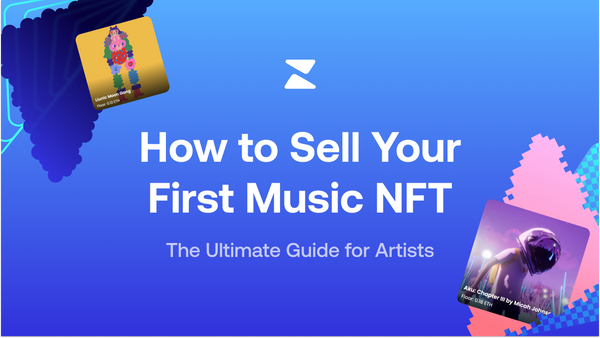You’ve heard that some digital artists made millions with NFTs. You know that music NFTs are a thing.
But if you try googling Web3 music, you get lots of hype about “the future.” And no instructions on how to get there.
In this guide, we’ll tell you everything you need to know to release your first music NFT — even if you know nothing about crypto, coding, or other tech stuff. We don’t promise you’ll make millions (you might, who knows), but you’ll get from 0 to at least 1 sold music NFT.
Table of contents:
- What are music NFTs?
- Why do people buy music NFTs?
- How to sell music as NFT
- Wallets for music NFTs
- Blockchains for Web3 music
- Where to sell: main platforms
- Create your first music NFT on Zora with Zerion
- How to promote your web3 music
- Web3 music players
Why listen to us?
We know a thing or two about NFTs.
The Zerion team has built the best wallet for Web3 and NFTs with over 100,000 active users. We also launched several NFT collections: Zerion Genesis, Zerion DNA, and many smaller ones.
Finally, we collect NFT music and know all the main players in the space. We’re kind of a big deal.
Now let’s get started!
What are music NFTs?
Music NFTs are non-fungible tokens with some audio files and accompanying images or videos.
Non-fungible means each token is unique and cannot be replaced with another one. In contrast, each ETH token is just like another. But each NFT is one-of-a-kind and traceable, even if has a certain number of copies.
Speaking of copies, NFTs could be:
- 1 of 1 or 1/1 — each NFT exists as a single edition, there is just one item in the collection;
- Limited editions — for example, 1 of 500 or 1/500, where each of the 500 NFTs in the collection is the same but has a unique number that identifies it;
- Open editions — usually, done as time-limited drops, where an unlimited number of copies can be minted (i.e., created) during a specific period (a day, a week, etc.);
- Drops — often a collection of 10,000, where each NFT has some unique attributes and media, making some items rarer than others. These attributes could be assigned randomly or based on some rules in the smart contract.
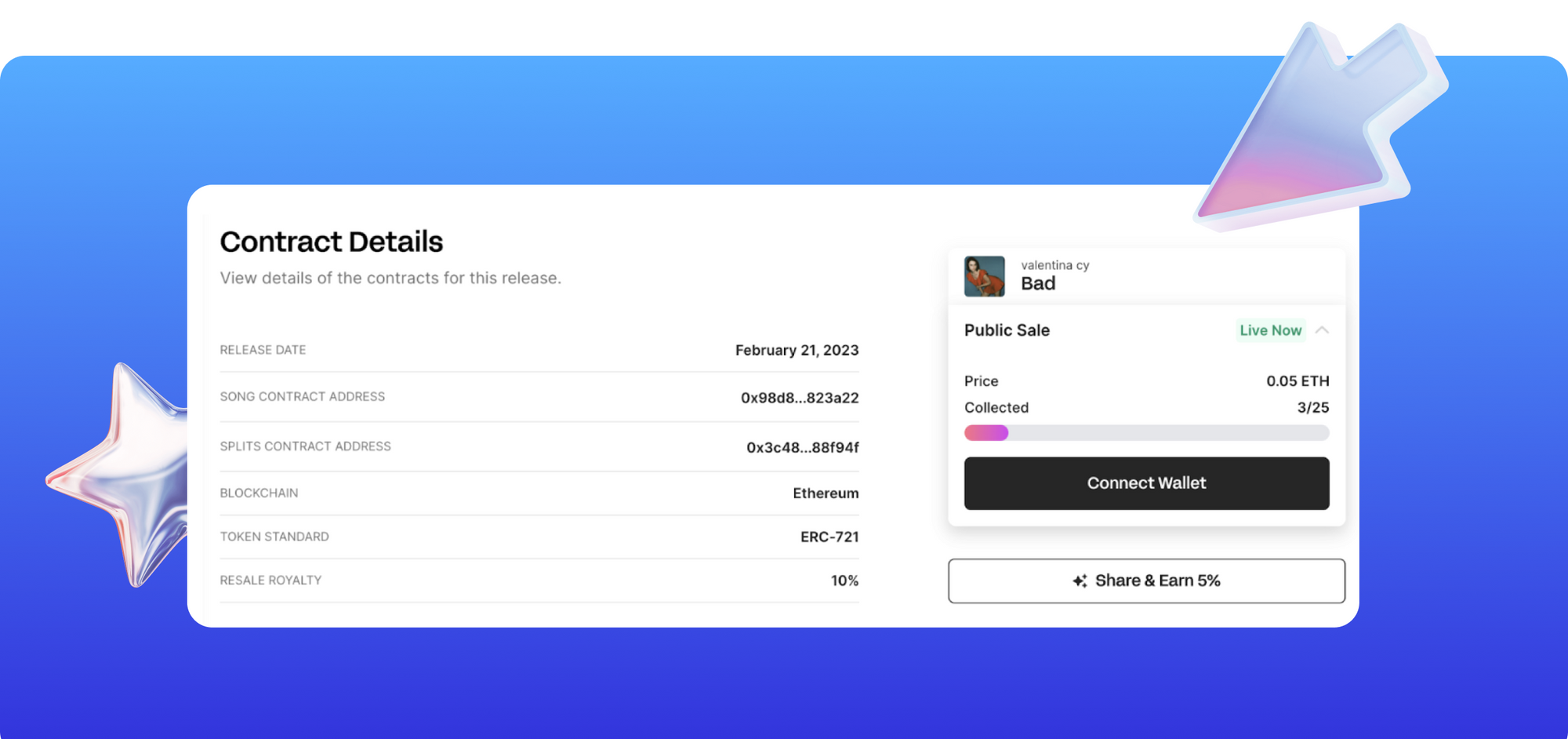
A smart contract is a program on the blockchain that defines how the NFT works. Don’t worry, you don’t need to code — most NFT platforms handle that.
The smart contract can also have resale royalty and splits. The splits mean you share revenue with other addresses (for example, collab partners or producers). The resale royalty gives you a cut every time some trades the NFT on the secondary market.
We’ll look into details later, for now, it’s more important to understand who and why buys music NFTs.
Why do people buy music NFTs?
You usually don’t need to own a music NFT to listen to the track.
Instead, people buy music NFTs mainly for two reasons: to support the recording artist and to speculate on the future market value of the NFT.
Collecting 1 Music NFT for 0.005 ETH pays the same as 2500 streams.
— Coopahtroopa 🔥_🔥 (@Cooopahtroopa) April 5, 2023
And you get a digital vinyl to show for it.
Buying a music NFT is a great way to support an artist. It’s like buying their merch or a limited edition vinyl record. But almost 100% of the proceeds go to the artist. And it’s all digital — there is no shipping or storage hassle.
Holding an NFT token can also open up opportunities. This could be early access to other releases, VIP invitations to gigs, direct contact with the artists, and more. Sometimes, the NFT might even grant certain legal rights, such earn royalties. All this is up to the artist to decide and could be an exciting part of the creative process.
Finally, the music NFT might eventually increase in price, just like any other NFT. However, for a true fan, potential profit is not the main consideration.
This is not just theory — thousands of people collect music NFTs.
On Sound.xyz, a leading Web3 music platform, collectors bought $4.5 million worth of music NFTs. It’s all on blockchain and the stats are open.
The total NFT music market in 2022 was valued at $1.7 billion. Even while crypto prices are down, people still collect NFTs, and new platforms have launched to make it easier for artists, music producers and collectors.
The great news is that it’s still early days, and new indie artists can get ahead if they catch this wave. Think of it like YouTube in 2008. You don’t want to miss this.
Now let’s see what you need to sell your music NFT.
How to sell music as NFT
To sell NFTs with music, you need several things: all the music stuff and some blockchain things.
First, gather everything you would need to release tracks on traditional music streaming platforms: music, cover image/video, and description.
You’ll also need this new and weird blockchain stuff:
- Web3 wallet — you need it to interact with the blockchain and smart contracts
- Crypto on a blockchain of your choice — you need this to pay to create smart contracts for NFTs and do things on the blockchain
- Smart contract — that’s a program that will run your music NFT. You don’t need to code anything, as most platforms take care of that.
The general process to make a music NFT is as follows:
- You create a Web3 wallet
- You define the settings for your NFT on one of the platforms: descriptions, number of copies, price, and the sale period
- People mint (i.e., buy) your newly issued music NFTs, paying with crypto from their wallet
- You get crypto in your wallet
- You can send crypto to an exchange and sell it for USD to withdraw to your bank account
As you can see, the process starts and ends with a Web3 wallet.
Wallets for music NFTs
To interact with any NFT platform, you first need a Web3 wallet.
It’s more than a simple crypto wallet you might already have on a crypto exchange. A Web3 wallet not only stores crypto but also lets you connect to NFT platforms. The wallet acts as both your login and password. You prove that it’s you by signing a transaction. Don’t worry, it will become clear once we go through the process.
While you can use any wallet, we believe Zerion Wallet is the best choice for both artists and collectors:
- NFT tracking, including Web3 music — listen to tracks right in the wallet, sort by collections, dates, and prices
- Mobile-first — connect your wallet to any apps on mobile and desktop, sign any transactions on the go
- Full support for Polygon and 10+ other networks — all blockchains, tokens, and NFTs show up right away without any manual settings
- Buy crypto with a card — no need to go to a crypto exchange just to get started
There are tons of other features that you will find extremely useful when you start your Web3 journey. For example, you can follow other wallets and get notifications when they mint or trade NFTs. And everything is packed in an intuitive and easy-to-use interface.
So if you don’t yet have a wallet, get Zerion Wallet.
The next thing you need is to pick a blockchain for your music NFT.
Blockchains for Web3 music
While there are many blockchains, the two most important ones for the music industry are Ethereum and Polygon.
Ethereum is the largest network and the original home of NFTs. Nearly all wallets, exchanges, and platforms support Ethereum and its token ETH (used to pay for transactions). Ethereum has over 220 million unique addresses (i.e., accounts) and about 500,000 unique daily active addresses.
The main problem with Ethereum is the high fees for transactions. Minting an NFT could cost $5-10 or even hundreds of dollars, depending on how busy the network is at the time of minting.
That’s where Polygon comes in.
Polygon is another blockchain technology that is faster and cheaper than Ethereum. Polygon works like Ethereum, except you need MATIC, its native token, to pay for transactions. Polygon has almost the same number of unique addresses and over 400,000 unique daily addresses.
Minting an NFT on Polygon is cheap and usually costs less than $1.
Overall, more wallets, platforms, and services support Ethereum, but it’s cheaper to get started on Polygon.
Where to sell music NFTs: main platforms
You can release and sell your music as an NFT drop on two types of platforms: permissionless and curated.
Permissionless platforms let anybody create and sell any kind of NFTs, including music. This is the beauty of Web3: anyone can get started, there are no gatekeepers, only the sky is the limit.
Curated platforms have some filtering. As an artist, you first need to fill out an application and get accepted. This is done to ensure the high quality of music and successful sales.
Here are some of the main platforms for selling music NFTs. Don't worry about trying them all — in a bit we'll give you the exact steps to mint your first NFT.
1. OpenSea
OpenSea is the best-known NFT marketplace that also lets you release music NFTs on Ethereum, Polygon, and other networks. OpenSea has an option to ‘lazy mint’ where you don’t pay anything to “create” an NFT until someone buys it and mints it.
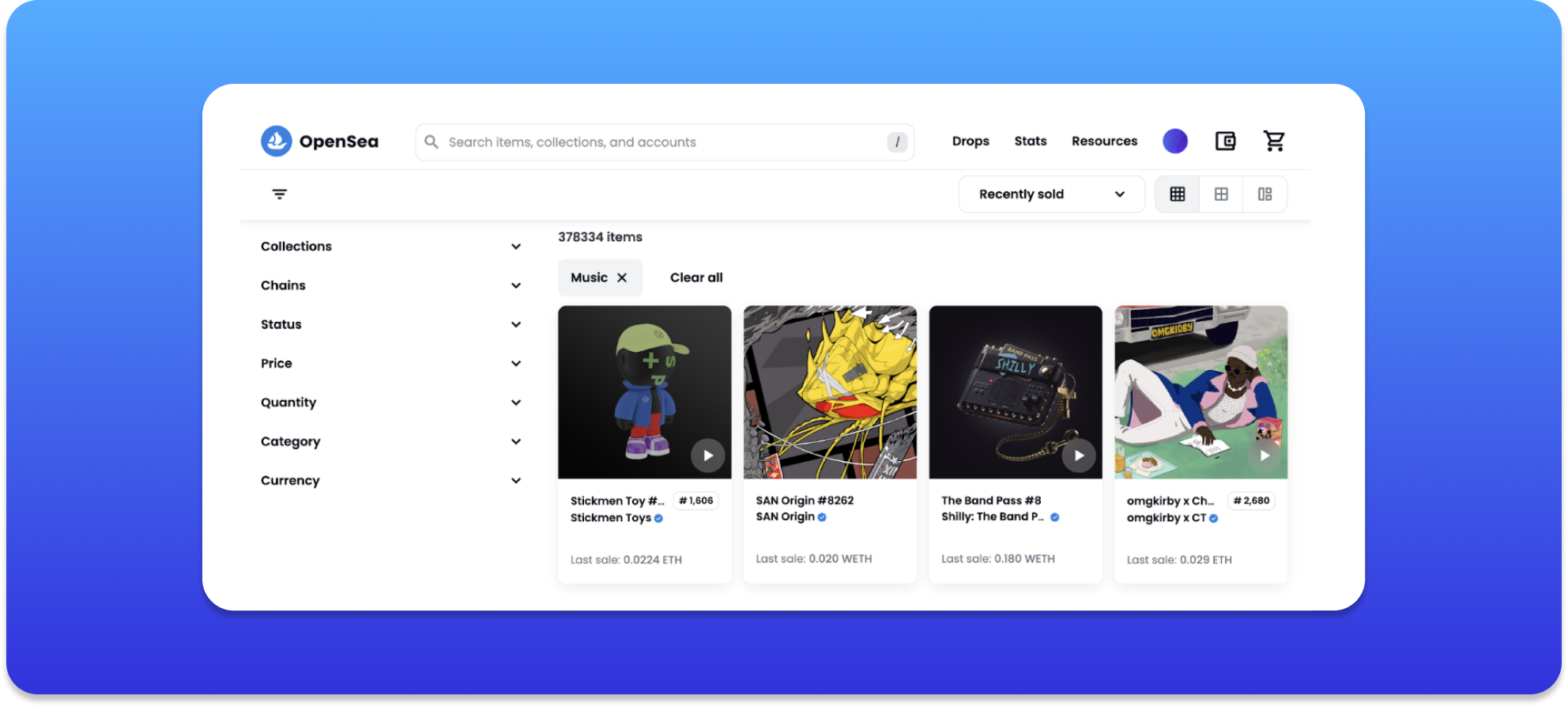
The main drawback of OpenSea is that it’s a very crowded marketplace: over 377,000 music NFTs are available on the platform. It’s unlikely that somebody will randomly find your music. You need to promote your NFTs to get noticed.
2. Zora
Built specifically for creators (instead of traders like many other NFT platforms), Zora focuses on making it easy to create NFTs.
There is also a built-in marketplace for secondary sales. Unlike other platforms, Zora only works on Ethereum.
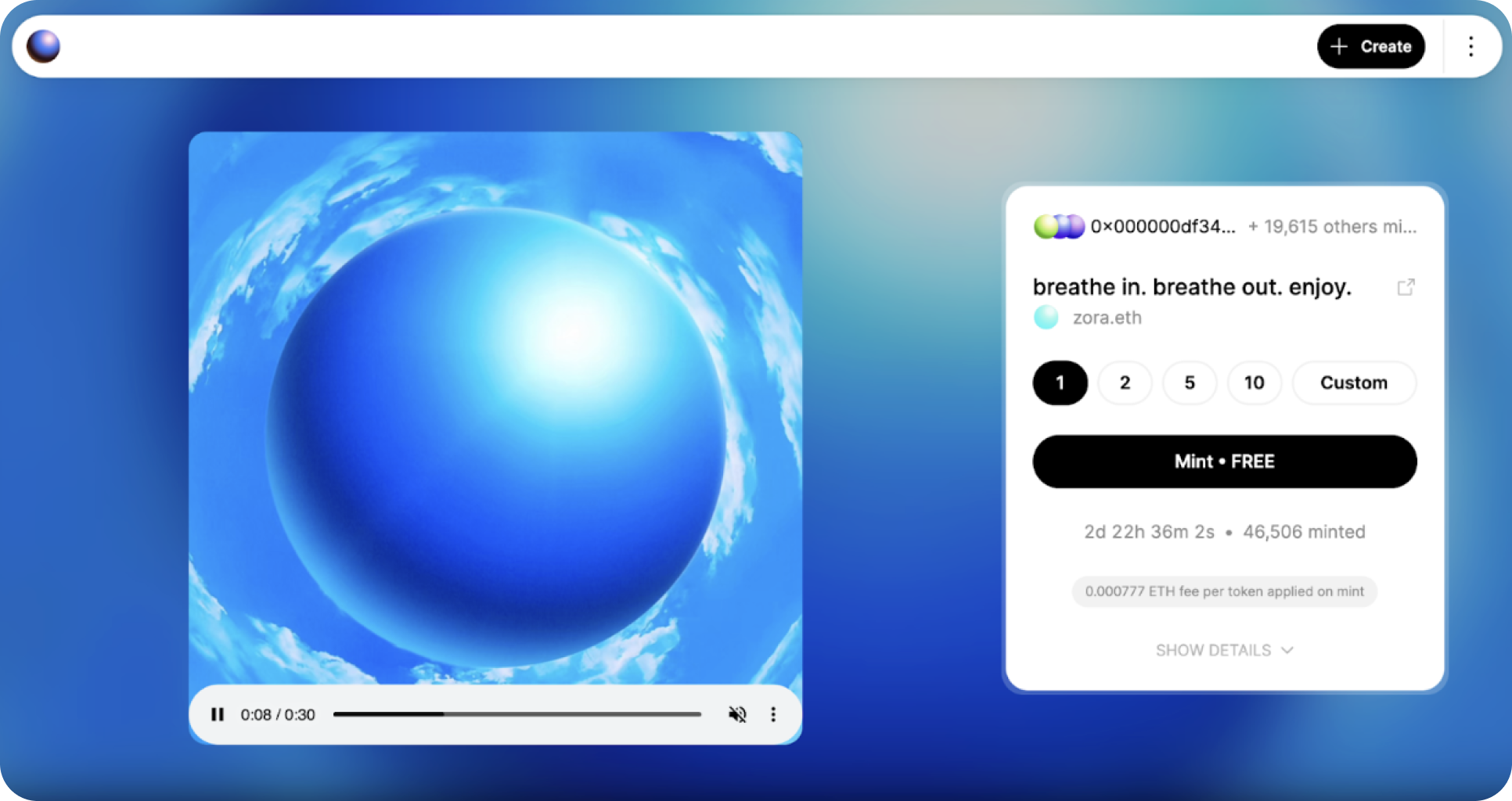
Recently active and trending NFT mints are promoted on Zora’s homepage. But it’s still not that easy to get discovered.
3. Lens Protocol
Lens is a web3 social media protocol built with NFTs on Polygon. Any post can also be turned into a collectible NFT — and it can include an audio file, turning it into a music NFT.
As a result, releasing music as NFT on Lens is almost as easy as publishing a post on a platform like Facebook. The built-in social graph also lets you gather followers and promote your music. Importantly, Lens is not a single app or a platform. It’s a protocol on which other social apps are built. Some apps, like Lenster.xyz, are general-purpose social media platforms.
Others, like Beatsapp are dedicated specifically to web3 music.
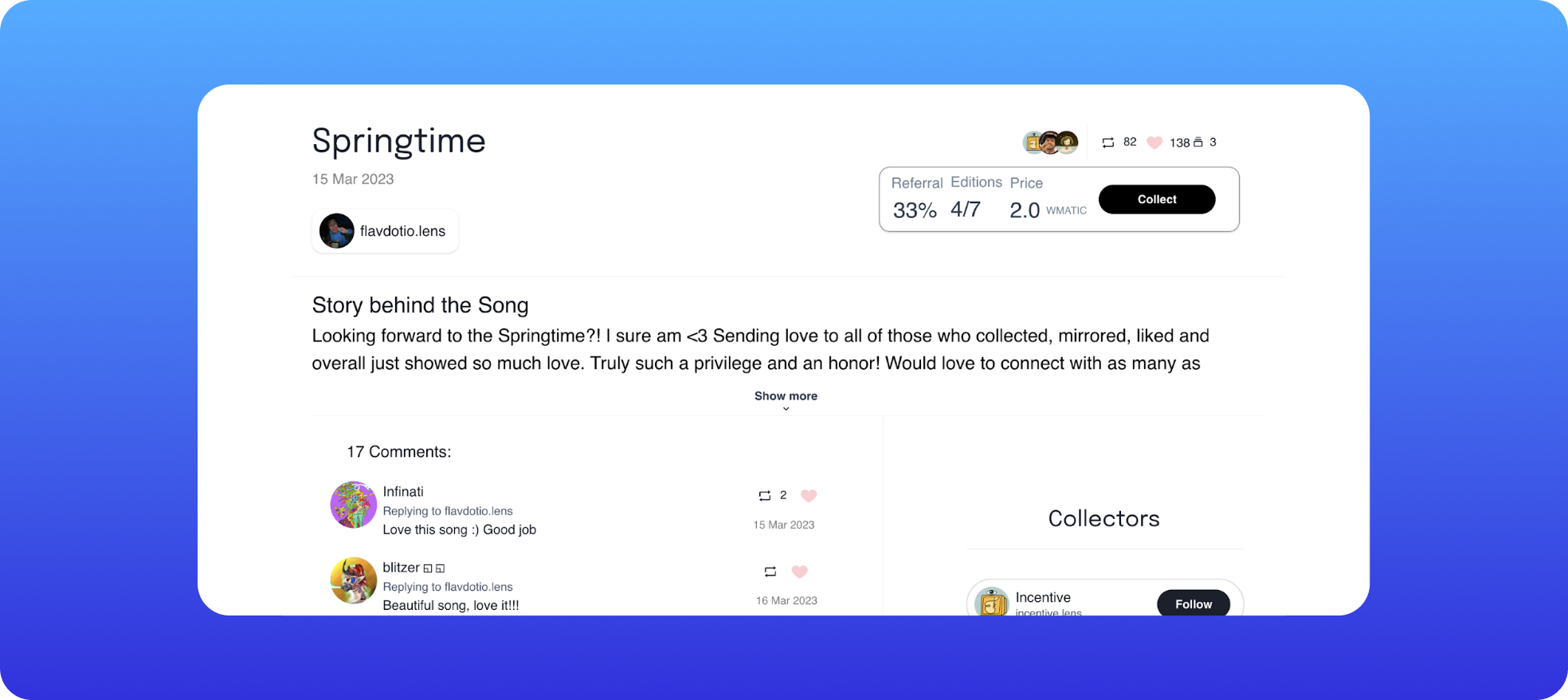
However, Lens is still in beta and is currently invite-only. To create a Lens account, you need to be whitelisted.
4. Sound
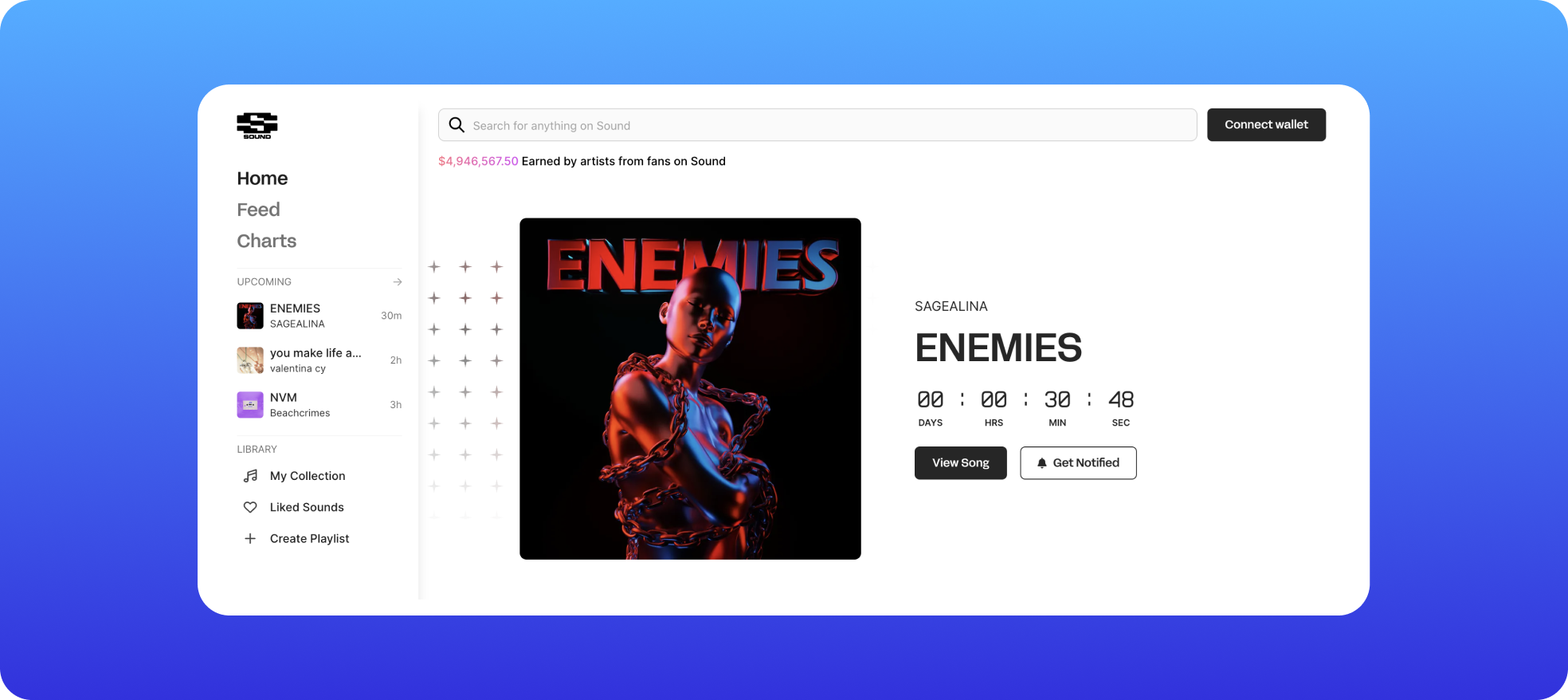
The leading Web3 music platform, Sound offers daily music mints and a music NFT marketplace for secondary sales. Sounds is focused on scheduled live drops, which are open for a limited time.
To start selling music on Sound, you need to submit an application, which are currently on pause. However, you can start hanging out in their Discord and build connections with other artists, which can help you get a way in.
5. Catalog.works
Catalog lets artists sell 1:1 music NFTs, which are sold through auctions or as ‘buy now’ listings.
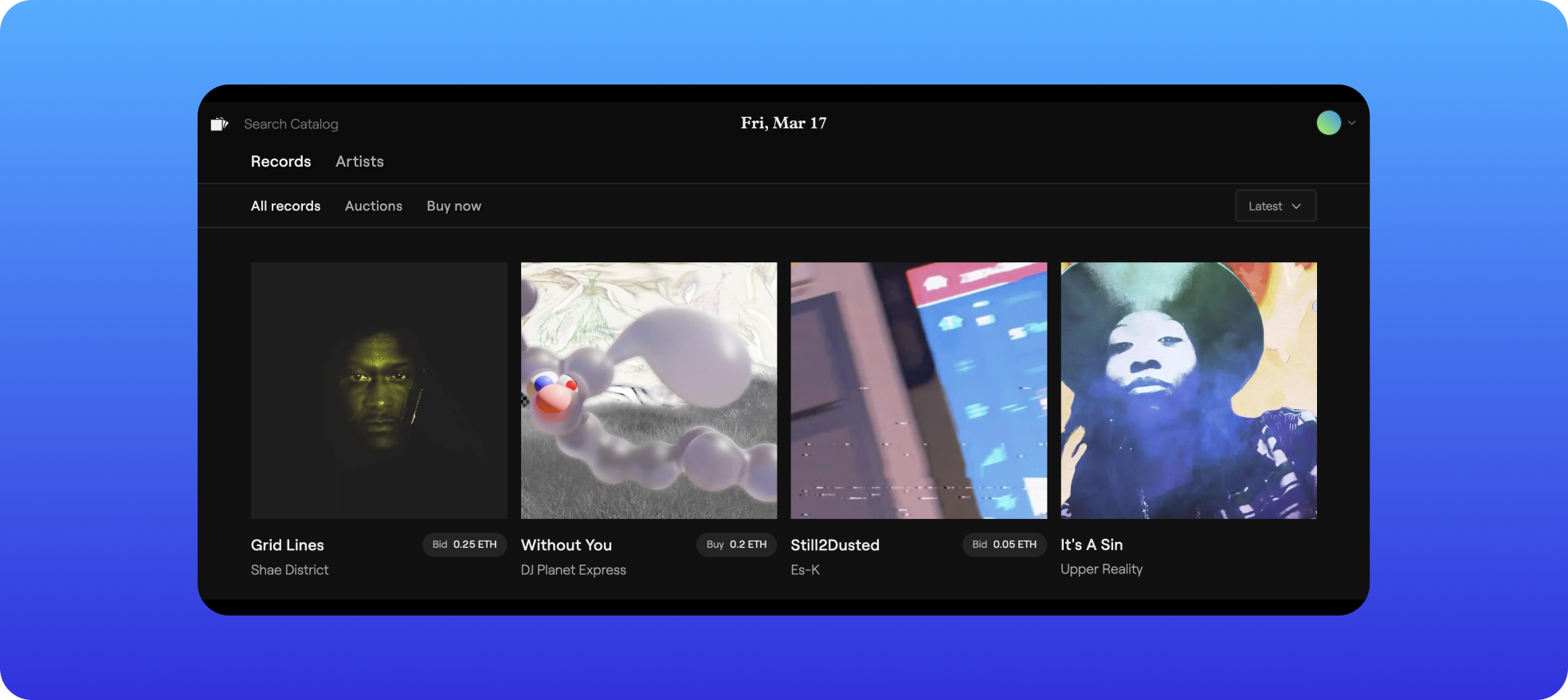
It’s a curated platform, so artists need to submit an application form to start selling. Catalog also seeks exclusivity from music artists: the same music should not be minted elsewhere.
There are many other web3 music platforms, but they all seek to do two things: first, let the artist sell the music and then let people trade it as NFTs.
Let’s see the exact steps you need to follow to create music NFTs.
How to make music NFT on Zora with Zerion
Now that let’s put all this theory into practice.
The general flow will be the same for all platforms and will use Zora as an example. We’ll assume that you start from scratch.
Step 1. Install Zerion Wallet.
Step 2. Create a new wallet by following the onboarding flow.
Step3. Buy some ETH with a banking card. Select Ethereum as the network. Although you won’t need much, the fees are lower if you buy at least $100 worth of ETH.
Step 4. Open Zora.co and click ‘Create’. Then select ‘Wallet Connect’, you will see a QR code.
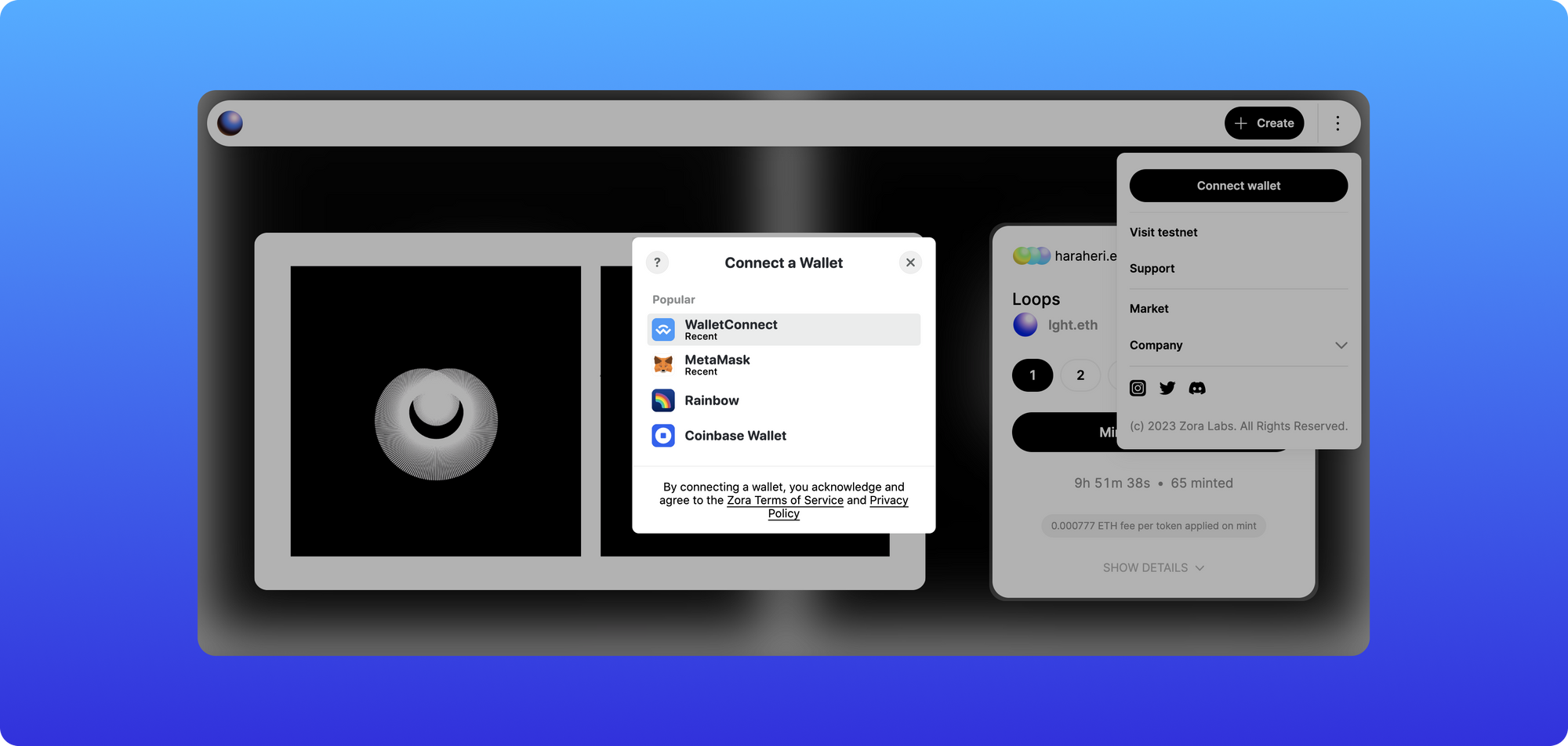
Step 5. Scan the QR code with the Zerion Wallet app. You will see a screen like this, asking you to connect. Just tap ‘Connect’.
Step 6. Now your wallet is connected to Zora — click on the little circle in the right corner and it will show something like 0x94.. that's the the beginning and the end of your Ethereum address.
Step 7. Once again, on Zora.co, click ‘Create’ and then ‘Edition.’
Step 8. Define all NFT settings and upload the media.

Most of the fields are self-explanatory, but let's go over some of the ones that are unique to NFTs.
Step 9. Once you’re happy with all the settings, click ‘Create’. Now open your Zerion Wallet.
Step 10. Sign the transaction in your Zerion Wallet to create the NFT collection and open it for minting — this will cost you some ETH. Exactly how much depends on how busy the network is. Expect to pay at least $30 (you pay this once, NOT every time someone mints your NFT).
That’s it!
Your music NFT is now live and is available for people to mint. Share it in Zerion’s Discord, and maybe somebody will mint it.
This is also a good time to talk about how else you can build a succesful music brand with NFTs.
How to promote your web3 music
If you simply create an NFT, it’s unlikely that it will go viral by itself.
You need to put some energy into promoting your NFT music. The three main channels are marketplaces, social media, and Web3 media.
Listing on other NFT marketplaces
If you create an NFT on one platform, you can also list your NFTs on other platforms and marketplaces.
The main NFT marketplaces are:
However, somebody first needs to mint your NFTs before they can get listed. You can even mint your own music NFTs from another wallet — it’s easy to create additional addresses in Zerion Wallet. Then just use that NFT to list it on those marketplaces.
Social media
While it’s helpful to be active on all social media platforms, the main channels for Web3 are Twitter, Telegram, and Discord.
Crypto Twitter is where all breaking news is happening, and new things get discovered. Start by following all the platforms mentioned in this guide as well as some accounts they follow. Here's a cheatlist from the co-founder of Sound.xyz.
New music blog era is taking shape.@invinmusic@ZiggyZiggyMusic @AbelowRob@Own_The_Sound @noisedao @RuncieDan @levychain @austin_hurwitz @arjanwrites @futuremusicpod@dreamsnevrdie @wavWRLD_ @futuresurfradio@water_and_music @jarrodT123
— Coopahtroopa 🔥_🔥 (@Cooopahtroopa) March 29, 2023
Curation is evolving 👀
Telegram has lots of different groups dedicated to all things crypto, including music NFTs. Get started by joining Telegram chats and channels of platforms mentioned in this guide.
Discord is another big platform for the Web3 community. You should join all Discord servers of the platforms mentioned in this guide. Start by joining Zerion Discord and share your NFT in the #musicNFTs channel.
Web3 media
Web3 also has its own media platforms.
Lens — we already mentioned Lens Protocol as a place where you can create NFT music or even music videos. But you can also share links to your other NFTs. And comment on posts of various influencers. If you don't want to wait to get whitelisted, you can buy Lens a handle to get started.
Mirror — think of it as a Web3 blogging platform. You can write your own blog or try to get featured in publications that cover Web3 music. Invest in Music is one of those blogs.
Farcaster — it’s another Web3 social media platform that also shows trending NFT mints and what your friends mint. It’s invite-only, but you can DM its founder Dan Romer on Twitter and ask for an invite. Just say you’re a Web3 artist and a big Zerion Wallet fan.
However, the best way to get in front of music fans and investors is to get featured in Web3 music players.
Web3 music players
These platforms aim to tackle two problems: discovering new music NFTs and getting discovered as an artist.
If you are an artist that's new to the space, the best thing you can do is find a couple of artists that are similar to you. Go and pick up one of their NFTs and join their collector chat. You'll start to see who are the people collecting the music of artists that are similar to you — Cooper, Sound.xyz
Oohlala
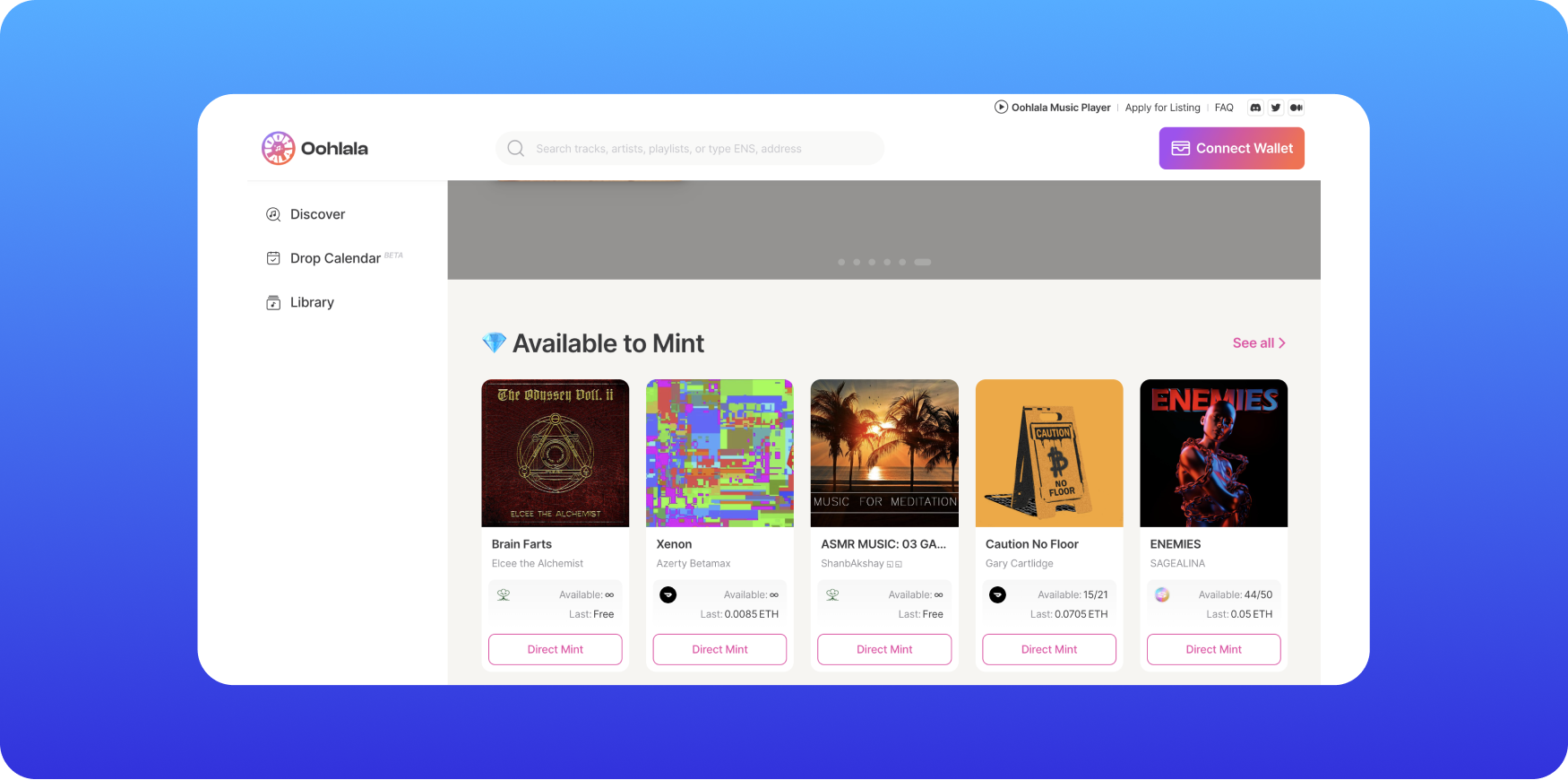
Oohlala is a Web3 music player & aggregator that seeks to improve the music NFT experience.
The Oohlala team has done all the heavy lifting of integrating different Web3 music platforms and music NFT collections to display them all in one place. All mints with music on Lens and Zora also show on their homepage.
You can also enter any address in the search and see what music they hold across many platforms and protocols. This can help you research artists that major collectors like.
The Oohlala player (available as a web app and on iOS and Android) also has queue and playlists, mirroring features of regular music streaming services.
Spinamp
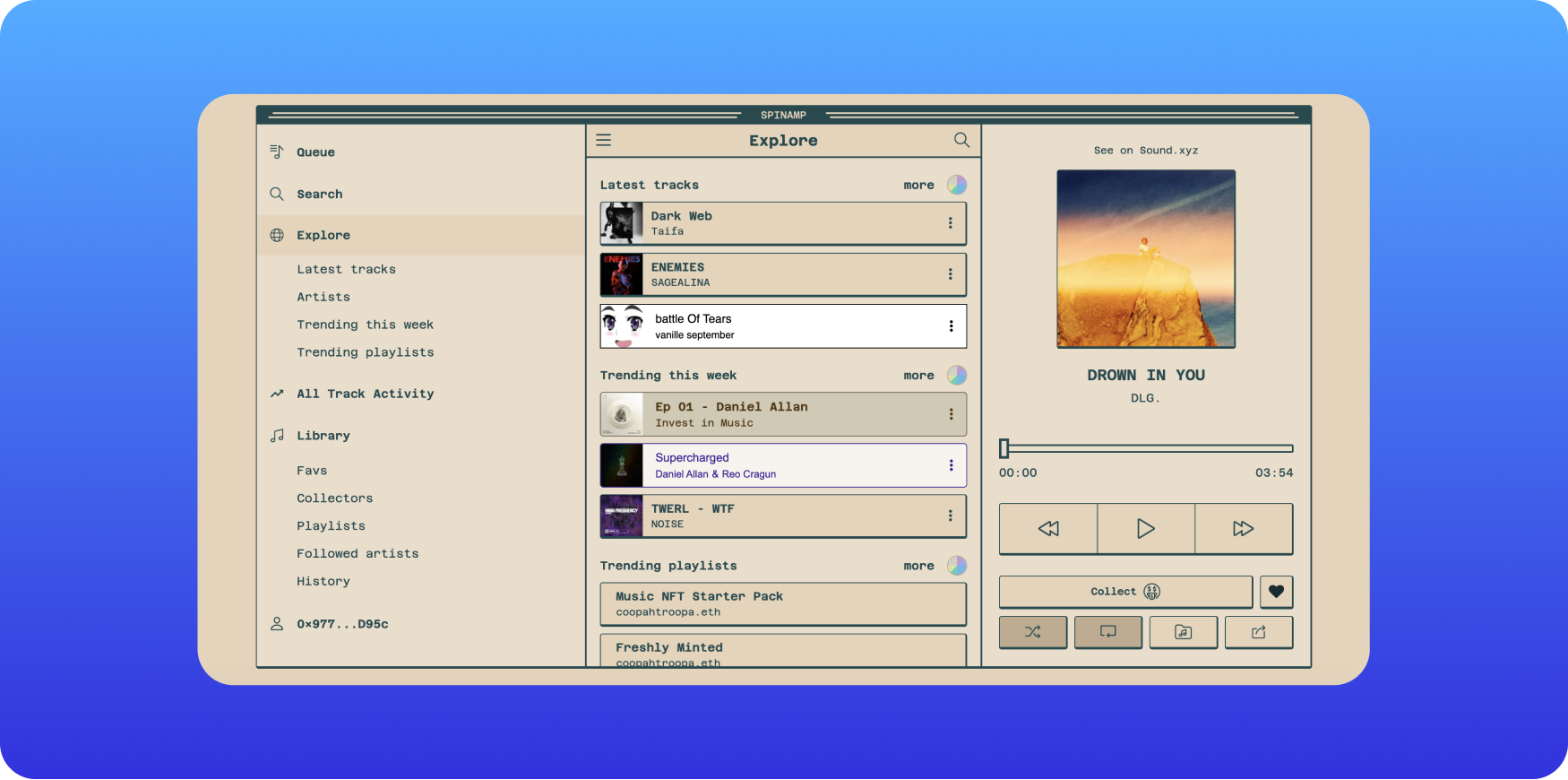
By aggregating trending tracks and playlists from Sound, Catalog, and other web3 music platforms, Spinamp helps to discover new artists and save tracks you like.
There is also an option to collect the track — Spinamp scans many marketplaces to find the best price.
But you don’t need to buy tracks. You can also save them to playlists and listen to them on the go with Spinamp’s mobile apps for iOS and Android. In fact, you can earn through curation: when someone buys a song from your playlist, you get a cut.
Finally, you can also follow many artists and collectors and see what they do in the music NFT space. That could be great to stay up to speed with the market.
Your turn: create your music NFT and share it with Zerion!
In this guide, we reviewed what music NFTs are, why people buy them, what you need to sell your first music NFT and where you can do that. After that, we went over the specific steps to creating NFTs.
However, the best way to join the Web3 music space is through doing, not reading. Go ahead and download Zerion Wallet.
Then create your first music NFT, and let us know on Twitter and in Discord!
FAQ
How to create NFT music?
On most platforms, such as Zora, you can create an NFT with any media, including audio and video files. To create NFT music, you can simply create a new NFT and select an audio file (e.g. mp3) with your track and a cover image (JPEG). You will then get a link to your NFT, which other users will be able to mint with their wallet.
How can a musician create a unique NFT?
The easiest way to create a new, unique NFT is with a platform like Zora. You don't need to be a developer or know how to code — it's as easy as posting something online. You will need a wallet for Zora like Zerion. On some platforms, you won't even need any money to create a new NFT.
How can I make money with my music NFT?
You can make money by adding a mint fee for your NFT — when people mint an NFT with their wallets, they will pay this fee in addition to gas fees. Some platforms like Zora also have platform fees, which they share with NFT creators. Again, collectors pay these fees for otherwise 'free' NFTs.
How to mint NFT music collections?
Minting an NFT music collection involves turning multiple tracks into unique digital assets on the blockchain. Here’s a step-by-step process:
- Choose a Platform & Blockchain – Select a marketplace like Sound.xyz, Catalog, or Zora, and decide whether to mint on Ethereum, Polygon, or another blockchain.
- Prepare Your Music & Metadata – Upload your tracks and cover art. Include details like track names, artist info, and descriptions.
- Set the Minting Structure – Decide on editions (1/1, open edition, or limited supply), pricing, and royalties.
- Mint the Collection – Use the marketplace or a smart contract to create the collection, paying gas fees if required.
- List & Promote – Share your NFT collection with fans through social media, Discord, and Web3 music communities.
How to mint music NFTs?
Minting a single music NFT follows a similar process but is focused on individual tracks:
- Select a Platform – Use Web3 music platforms like Sound.xyz, Catalog, or Manifold.
- Upload Your Music – Provide the audio file, artwork, and relevant metadata.
- Choose Minting Details – Set pricing, royalties, and edition size (single edition or multiple copies).
- Mint the NFT – Deploy it on your chosen blockchain, paying gas fees.
- Sell & Share – List it on marketplaces and promote it to your audience.
By following these steps, artists can turn their music into NFTs, giving fans a way to collect, trade, and support their work on the blockchain.

